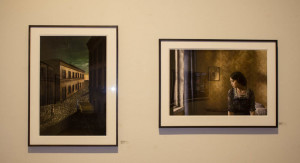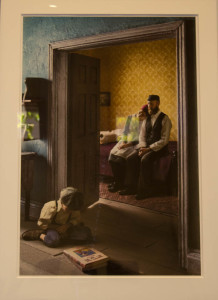Tags
Related Posts
Share This
Once Upon a Time in Kazimierz

Richard Tuschman’s photos “Mystery and Melancholy of a Street” (left), and “Pale Light” (right), featured in photo-eye’s gallery. Photo by Cris Galvez.
A young woman in a floral blue dress and a white apron, her hair pulled back in a red scarf, sits a bed inside a room with yellow wallpaper. She leans her head on a man’s shoulder; he has a thick beard and wears a blue hat. Their eyes are cast downwards towards the carpeted floor. A few feet away from the doorway, a little boy sits on the ground staring at a small stack of books intently.
From Sept. 16 to Oct. 29, Richard Tuschman’s photo novella, “Once Upon a Time in Kazimierz,” is being featured in Santa Fe’s photo-eye Gallery. Framed photos from the series line the walls of the spacious rectangular building—a little hole in the wall hidden away behind the New Mexico Bank & Trust building.
Tuschman, who was always drawn to photography, didn’t seriously begin photographing live models until Photoshop was introduced in the 1990s.
“When I went to school at the University of Michigan back in the 1970s, I studied printmaking and painting,” Tuschman recalls. “I only took one darkroom course, and wasn’t very good at it, but I always incorporated photography into my work. Photoshop was the first “darkroom” I felt comfortable with.”
The photo novella follows a fictional Jewish family living in Poland during the 1930s. Tuschman was inspired after visiting Krakow with his wife, who grew up there.
“I was incredibly moved by the architecture. A lot of it dated back to gothic and renaissance times,” Tuschman says. “I also have Jewish ancestors who came from Warsaw and other nearby areas, so visiting the historical Jewish neighborhood inspired me deeply on an aesthetic and familial level.”
Tuschman’s photographs are not entirely organic, as they combine digital photography with handmade dollhouse-sized dioramas.
“I built, painted and photographed the sets in my studio,” Tuschman explains. “Then I photographed the live models against a plain backdrop, and made the digital composites in Photoshop.”
While Tuschman strives to make the miniature sets as convincing as possible, they tend to deviate away from reality just enough to enhance the theatrical, slightly surreal mood. He used the same process when while working on “The Hopper Meditations.”
“This is our second time featuring [Tuschman’s] work,” says Anne Kelly, gallery director and curator. After relocating to a new space 2 1/2 years ago, photo-eye celebrated its move with Tuschman’s first show, “The Hopper Meditations,” a series of photographs inspired by Edward Hopper’s paintings.

Richard Tuschman’s photo “Once Upon a Time,” featured in photo-eye’s Gallery. Photo by Cris Galvez.
“We wanted to show work from an artist we hadn’t shown before, and we had seen Richard’s work through Critical Mass,” Kelly says. “Ever since then, we’ve continued to work with him. This exhibition is in honor of the completion of his new project and we’re very enthusiastic about it.”
photo-eye prides itself on showing work from photographers that use photography in unique ways. Having been established as a bookstore in 1991, photo-eye started as a mail order book business out of Austin, Texas before moving to Santa Fe. When the bookstore opened in Santa Fe, the gallery organically grew out of it only a few years later.
“We have everything from platinum prints to figment prints, photos shot with digital capture, photos shot with film—any sort of hybrid process,” Kelly says.
Tuschman admits that most of his projects tend to reflect his melancholic nature, and that “Once Upon a Time in Kazimierz” deals with themes of fragility, loss and alienation.
“The neighborhood of Kazimierz as it existed in 1930, which is also the setting of our story, is a metaphor for loss and decay, since it declined significantly from its previous prosperity and cultural vibrancy,” Tuschman says. “But, ultimately, I want the viewer to feel empathy for the characters.”
“Once Upon a Dream in Kazimierz” will be featured at the photo-eye Gallery on 541 S. Guadalupe Street. The gallery is open 10 a.m. to 5:30 p.m. Tuesday through Saturday.






 Jackalope Magazine is the student magazine of Santa Fe University of Art and Design. Building on the interdisciplinary nature of our education, we aim to showcase the talent of our university and character of our city.
Jackalope Magazine is the student magazine of Santa Fe University of Art and Design. Building on the interdisciplinary nature of our education, we aim to showcase the talent of our university and character of our city.
Recent Comments